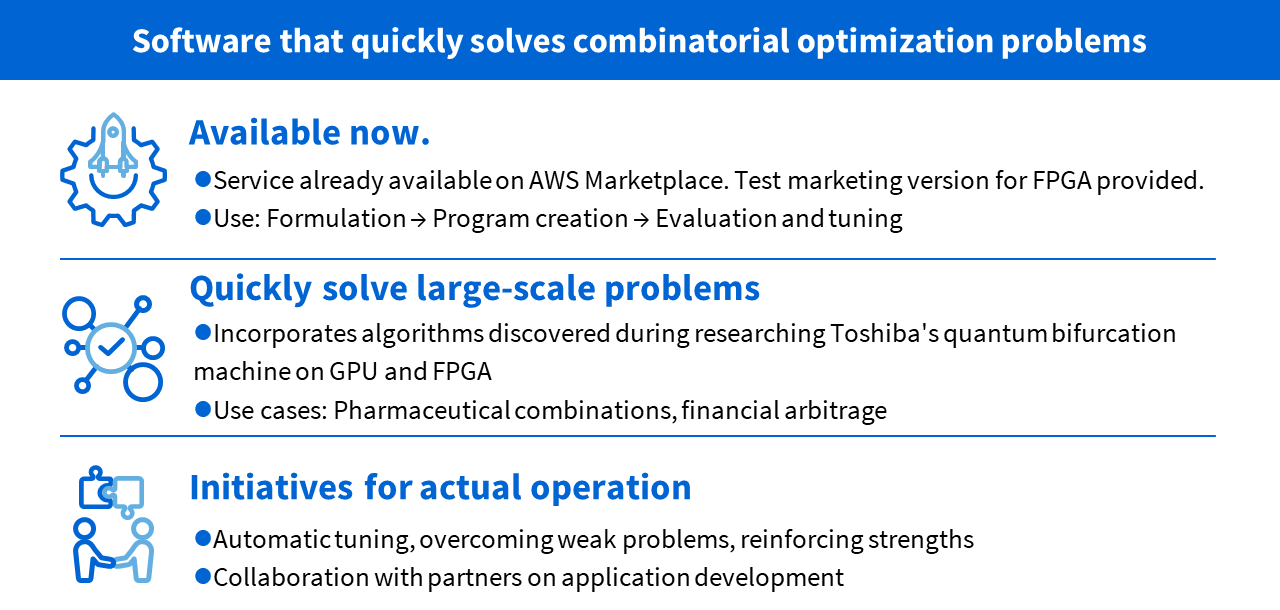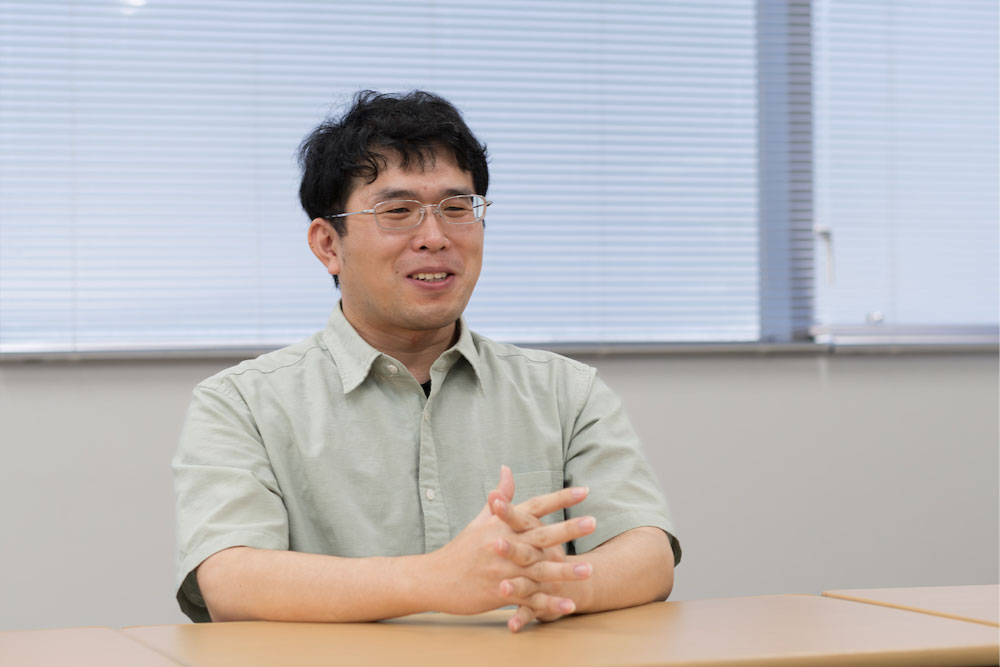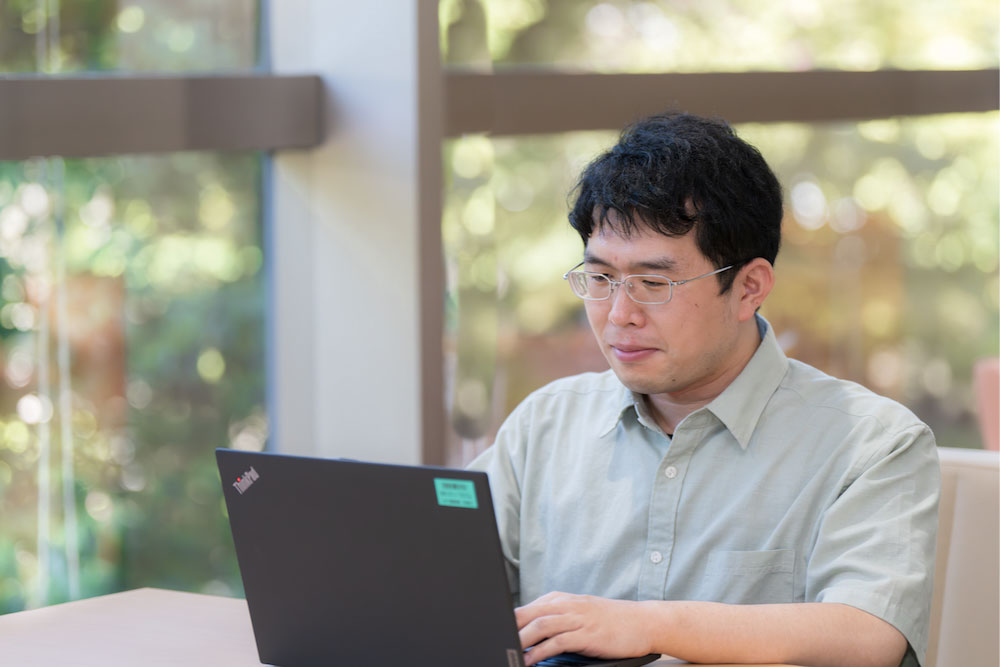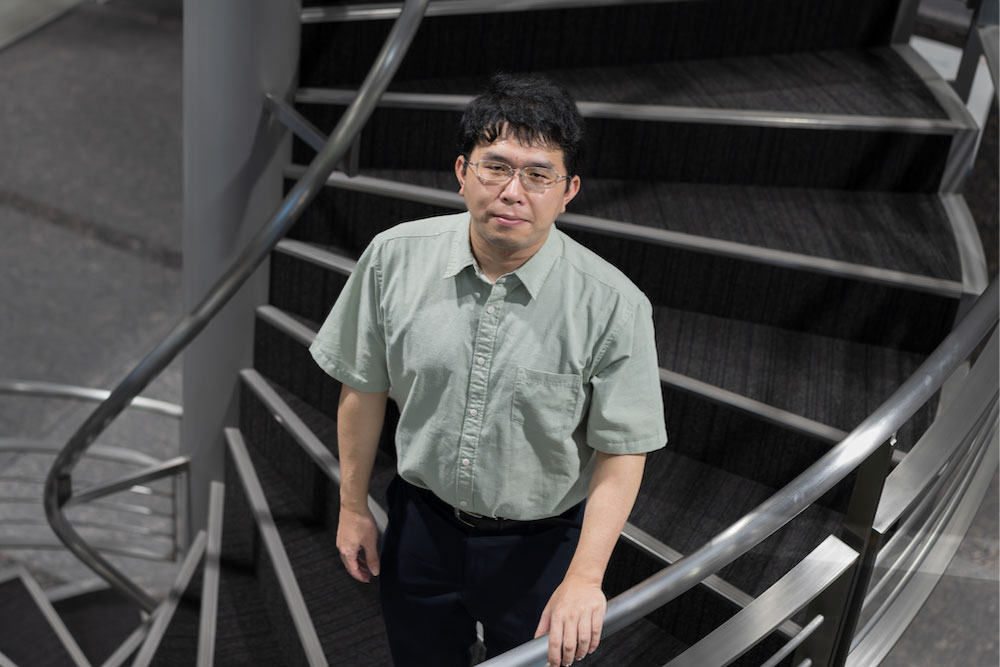We are Toshiba: Combinatorial Optimization Problems solved by Quantum Inspired Algorithms -An Endless Journey to Higher Levels
2024/07/25 Toshiba Clip Team
- Software that simulates quantum computer calculation methods
- The power of engineers in finding new methods to solve ‘combinatorial optimization problems'
- Derive new solutions by “creating together” not by going it alone

The “We are Toshiba” series of employee stories looks at people who are making tomorrow by solving problems today. Here we introduce Akira Yajima, an ambitious young software engineer at Toshiba Digital Solutions who has taken on the challenge of developing computing technology that can solve apparently intractable problems. Anticipating the quantum age, Yajima is working on quantum-inspired optimization solutions. What clues to digital solutions are to be found in taking on unexplored optimization challenges, what insights are there for social implementation?
Pseudo-quantum computing technology that uses standard computers to solve large-scale combinatorial optimization problems
Quantum technology is constantly in the news for its potential to bring ultra-high-speed computation to solutions to very difficult calculation problems. Research and development is fast advancing toward practical application in areas that include highly secure communications, and ultrahigh-precision sensing.
One promising area is “quantum inspired,” which simulates the computational methods of a quantum computer on a standard classical computer. Yajima works on development of the technology at Toshiba Digital Solutions, and we talked to him about its characteristics and how it will contribute to solutions to social issues.
“People always look for maximum results in the minimum time, and that’s truer than ever in today’s digital world, in fields such as manufacturing, logistics, finance, and drug development. Manufacturers want optimized production processes; in logistics, it’s all about the most efficient delivery routes; financiers want to optimize portfolios and generate returns while minimizing risk; while pharmaceutical companies want to design molecules that lead the way to new drugs. These are all combinatorial optimization problems, where the best choice has to found from among many candidates. The obvious answer is to use a computer. But that’s easier said than done; these problems are really difficult to solve with current computers, because the number of combinations increases exponentially with the scale of the problem.
“Here’s an example of what I mean. An airport has to timetable ground staff. It needs to assign employees with a certain level of language skills, it has to provide breaks during the workday, and to schedule shifts that factor in skills and working hours. When you add variables like prescribed working hours and individual preferences, you reach a point where it requires an enormous amount of time and effort to organize the work shifts of hundreds of people. Quantum-inspired optimization solutions are the answer to challenges like this. They find solutions for a wide range of issues without being limited to a particular area.”

As the number of combinations increases, it becomes very difficult to compute them in a reasonable time. SQBM+™ solves such problems quickly.

Akira Yajima, Group 3, Software Development Dept., Software Systems Research and Development Center, Toshiba Digital Solutions Corporation
Companies and countries around the world are vying to develop quantum computers, but there are still many barriers to widespread use. Development work is currently limited to highly specialized environments and methodologies, such as extremely low temperatures near absolute zero, and the use of photons and special chips.
Toshiba’s products are different. They are based on algorithms—instruction sets for computing problem —and have no need of special environments, hardware, or platforms. The fruit of research into quantum computers, Toshiba’s breakthrough brings completely new principles to solving combinatorial optimization problems. It was first announced to the world as the Simulated Bifurcation Algorithm, made into software, and released as the quantum-inspired optimization solution, SQBM+™. It uses standard computers to solve complex, large-scale combinatorial optimization problems quickly and with high accuracy.

Features of the SQBM+™
Day-to-day work with solvers that influence solution functionality
Yajima joined the SQBM+ development team in 2021. His role is to improve solvers, software tools that address optimization problems, by improving current capabilities and implementing new ones, boosting processing speeds, expanding the scale of problems that can be calculated, and even adding new solvers. He comes up with an idea, makes a prototype, and confirms performance. It is all a steady effort to carefully examine performance and advance development toward commercialization, and one that is meeting a solid response.
“Getting effective output from solvers really depends on the skill of the user. Any problem to be solved must first be transformed into a combinatorial optimization problem, and rendered as a mathematical expression that an SQBM+ solver can handle. Then there is a limit to the size of the problem that each solver can handle, so we have to try to stay within that limit. Beyond that, creating input data has to follow procedures specific to the input data formats that can be handled, and the way to get better results is to have and use a wide range of skills. Of course, we also need these skills to expand SQBM+’s functionality, and we are conscious of the need to improve its usability. I draw on the software development knowledge I have gained in the five years since starting work, and knowhow from when I was a student. That came as a pleasant surprise. I never thought that my efforts as a student would lead to a job.”

Yajima studied physics at university, and did research in statistical mechanics. He repeatedly constructed mathematical models on a computer and ran them through simulations. As he immersed himself in this, he acquired software development skills along the way. He came to wonder if he could contribute to society by building software by hand and creating value. While working hard on this computer-based research, Yajima developed the desire to become someone who could create something on his own, and decided to join Toshiba.
“SBQM+ development requires extensive knowhow in software development,” explains Yajima. “A good knowledge of mathematical science is also essential when it comes to considering the relationship between solvers and mathematical formulas. I see no end to the things that I can learn; I also feel that I can contribute in many different ways, and that to do that there are places where some degree of autonomy is required.
“The knowledge base I built up as a student and as a newcomer to the company provided my foundations, and I have since added knowledge gained in my work. This gives me a perspective where I can look at software configurations and systems as a whole. Being able to see the overall structure allows us to accelerate expansion and improve functionalities.”
There is clearly a lot to learn, and areas that need to be pursued continue to expand. Yajima knows that there is no silver bullet for the development of digital solutions, no single breakthrough that will solve difficult problems. The way forward is by accumulating, trialing and verifying technologies, and the only route to achieving positive results is steady work.
“My starting point was IoT software development; I did that for the first year or two after starting work. It was the first product I worked on, and I completed the development with the help of my co-workers; they gave me a lot of suggestions during design and implementation, and I made corrections every day. The only way to solve problems and get to the goal is through steady work and the support of colleagues.”
Envisioning and Creating Digital Solutions Together in this Age of VUCA
Yajima has expanded the functions of SQBM+ and removed many limitations. He says that the basis of his success lies in the spirit of development, something he became aware of while still a newcomer to the work.
“I didn’t specialize in software development at university, but I received really a lot of pointers after I started work and realized these were the basics of software development, the essentials that I absolutely had to keep in mind. If I had to condense it all into a few words, I would say make it easier for users to use. My experience then is the foundation for my current software development.
“What I now enjoy most about my work is thinking about the application of technology and theory, and imagining how to incorporate them into a solver. When I read a paper or pull out a book, I lose track of time as I think about this and that. If this helps me to come up with a new use for the solver, and I can look at improving it or implementing new features.
“My first thought on using new technology is to make SQBM+ easier for people to use. Looking beyond that, I think what lies ahead is implementing solutions that contribute to society, the resolution of combinatorial optimization problems that confront every field.”

SCBM+TM offers solutions in many areas of society
As Yajima pointed out, SQBM+ does not accept all formulas. For instance, some optimization problems may include third-order or higher terms. If they are to be solved, they have to be converted into quadratic equations or other, but doing this degrades performance and the derivation of accurate solutions. Yajima questioned this, and wondered whether it was possible to ease the restriction and advance ease of use. It was a tough problem, but he took it on and adjusted the algorithm, so that it could handle quartic terms instead of being limited to quadratic. By taking advantage of features of the algorithm and tweaking it to handle higher-order terms, he secured higher performance for handling real-world combinatorial optimization problems.
“This extension allowed us to implement a solver that is easier to use. We could do it smoothly because SQBM+ is constructed with excellent algorithms and software, and because our organizational culture is open to exchanges of ideas and new approaches. Is there anything we can add to the solver? What can we do to make the user interface even easier to use? We constantly think about these things.”

Yajima’s guiding spirit in software development is a focus on user-friendliness, the incorporation of easy-to-use functions, and continued improvement. In the course of promoting these, “Creating together” is the Toshiba value that most strongly resonates with him, and he puts this at the heart of his work. Thinking about the application of new technology is a key part of his job, but he is quick to admit that considered opinions and idea from his colleagues, shared during chats and discussions, help to refine functionality and implementation. New things emerge from the accumulated knowledge and skills of many people. Yajima has embarked on a journey without end, toward the ultimate in quantum computing. There are countless people around him, moving forward with confidence.
“SQBM+ can solve social problems. There is still a lot to do. We have to add and change algorithms, and extend functions. Overcoming these problems will expand possibilities. However, there is a limit to the range of time and technology and the energy that one person can cover to make society better. That is why I really value helping one another. Many times I have been helped, and there have been times when I have offered help. Working together like this brings us much closer to our goals. Combining the skills and knowledge of colleagues exponentially increases total power and realizes a major driving force. Guided by the value of “create together,” we support one another and move forward together.”


![]()
Related Links
*This section contains links to websites operated by companies and organizations other than Toshiba Corporation.
Quantum-Inspired Optimization Solutions SQBM+ | TOSHIBA DIGITAL SOLUTIONS CORPORATION








